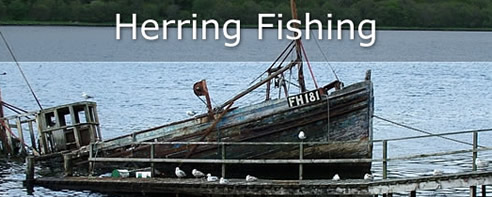
Herring Fishing In Loch Fyne
The Past
Loch Fyne saw the appearance of the 'trawl' in the early 1830's at a time when drift-nets were stretched across a bay to enclose a schoal of herring. Tarbert fishermen designed small nets for hauling herring to the shore, but it was alleged that these new nets killed the young herring at the same time with the more mature herring caught. The argument by the opposing fishermen to the new nets resulted in trawling becoming illegal by Parlaiment in 1851 to 1867. Between these years there was some conflict, in 1853 Colin McKeith of Tarbert was shot and wounded near Skipness by a crew from HMS Porcupine. Between these years 26 Tarbert fishermen were imprisoned in Campbeltown.
Loch Fyne was abundant with herring in the mid 1800's, Tarbert was the starting place of trawling, and battles ensued for many years between Tarbert fishermen and the smaller boats, presumably because of the unfair catch distribution due to the nets.
Trawling still went on despite becoming illegal during the 1800's and precautions were taken to hide the nets from the police and anyone else that would be snooping or watching out for the trawling.
Spawning.
Winter spawning of herring in the Clyde occurs off the Ayrshire coast, and off of the south-west coast of Arran. Fishermen during the 19th century found that herring also spawned in Loch Fyne. There was also supposed to be herring-spawning off the east coast of Kintyre, but this was only certain years.
It is told that there were years when there were few herring but 1938 there were plenty, with some catches being dumped if they couldnt sell it, because of the abundance the prices were low and you had to be quick landing to get your pay.
Movement
It is known that as night falls, herring leave deep water to seek the shores and as day breaks the herring return to the deeper water.
If gannets were seen diving steeply, it was an important sign that they were feeding on large herring, instead of smaller fish which they catch by diving at a much shallower angle as they would be closer to the surface.
Another sign would have been the rising of many groups of bubbles caused by the herring releasing gas as they swam to or at the depths of the waters.
The 'herring-whales' were also a sign of plenty of herring, especially when feeding.
Phosphorescence
In late summer and autumn, herring at the waters surface feed on phytoplankton that produce a phosporescent glow. This was watched for by fishermen in their boats chapping at a particular part of the vessel to cause sound waves to transmit to the water, sometimes the herring would move in reply to the sound, thus displaying the phosphorescent glow of the moving phytoplankton and enabling the fishermen to locate the feeding herring. This phosphorescence is very rarely seen during the wintertime.
Echo-sounder
The echo-sounder was introduced in the 1930's but not adopted by most vessels until the 1950's. This proved essential equipment for locating schoals of fish. The echo-sounder sends sound waves to the sea bed and it reflects back to the sounder where different grades of colour identify depth of the objects, it makes it significantly easier to track and locate fish, although it never entirely replaces conventional wisdom and traditional methods.
Fishing Grounds
Despite having echo-sounding equipment fishermen now and in the past have to keep a knowledge of submerged rocks, or other dangers, such as running aground, or snagging nets on sharp obtrusive objects on the sea bed. The fishermen through time have passed down the knowledge from skipper to skipper where the 'dry' grounds are so that the vessels are less likely to damage their nets on a trawl. Often bad places and potentially damaging objects were named so that different vessels would know not where to go.
Jellyfish
The objects affecting trawling along the shoreline were not the only problem for Tarbert and other fishermen. Jellyfish affected the 'ring-netting' severely at times, some catches in fact had such a high quantity of jellyfish in with the herring, the herring were spoiled as the fish became soft and descaled.
Fish Markets
In the 1870's herring was bought on the Clyde fishing grounds buy chartered steamers, catches were bid and bought whilst at sea, hence the terme 'floating market'. Fish caught early that morning anything up to 3am could be fast-tracked to Glasgow for sale at the fish markets that morning almost as fresh as when it was caught.
It is thought that in 1900, £31,305 of herring totalling 69,719 cwts were shipped aboard such steamers in Loch Fyne. But as with the varying abundance of fish supplide to the markets, the price fluctuates accordingly, and in 1901 £29,578 of herring totalling 89,039 cwts were shipped aboard steamers, more herring, but valued at much less.
Drift-netting
Persisting well into the 20th century, drift-netting as being used centuries before trawling or ring-netting A mile of net, or more would be set in the waters during early evening and the vessel and net would simply drift through the night, if herring were swimming where the nets were drifting then the herring might have been caught.